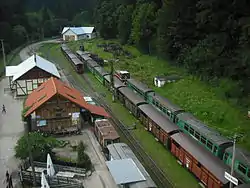Bieszczady Forest Railway
Bieszczady Forest Railway (Polish: Bieszczadzka Kolejka Leśna) is a 750 mm (2 ft 5 1⁄2 in) narrow gauge railway built in a sparsely populated, forest region of Bieszczady Mountains. Construction commenced at the end of 19th century and completed before the World War I. It stopped a regular traffic in 1994. Nowadays, a part of the railway is utilized as a tourist attraction. Trains run regularly on weekends from the beginning of May till October. In July and August also on weekdays.
| Bieszczady Forest Railway | |
|---|---|
| Bieszczadzka Kolejka Leśna | |
 On a track towards Przysłup | |
| Locale | Bieszczady, Poland |
| Terminus | Majdan |
| Coordinates | 49.205829°N 22.298700°E |
| Commercial operations | |
| Original gauge | 760 mm (2 ft 5 15⁄16 in) 750 mm (2 ft 5 1⁄2 in) |
| Preserved operations | |
| Owned by | State Forests |
| Operated by | Fundacja Bieszczadzkiej Kolejki Leśnej |
| Stations | 5 |
| Length | 20 kilometres (12.4 mi) |
| Preserved gauge | 750 mm (2 ft 5 1⁄2 in) |
| Commercial history | |
| Opened | 1898 |
| 1944 | ceased operation due to war damages |
| 1953 | taken over by State Forests, reconstruction started |
| 1963 | passenger traffic renewed |
| Closed | 1994 |
| Preservation history | |
| 1997 | Re-opened as a heritage railway |
| Website | |
| http://kolejka.bieszczady.pl/ | |
The main station with all the rolling stock is located in Majdan near Cisna.

History
A construction of a narrow-gauge railway in Bieszczady mountains started in 1890, when Galicia was under Austro-Hungarian rule. Its main purpose was to make easier forest exploitation, by linking a heart of Bieszczady with standard-gauge First Hungarian-Galician Railway (Erste Ungarisch-Galizische Eisenbahn) in Nowy Łupków.[1] The first line, 25 km long, led from Nowy Łupków eastwards to Cisna, mostly along Solinka river valley, and was opened on 21 January 1898. The gauge initially was 760 mm. The railway was operated by kkStB, and there ran two pairs of mixed trains and a number of timber trains daily.[1] In 1900-1909 there were built further private forest extensions from Cisna towards Kalnica, Beskid (part of Smerek) and Roztoki Górne.[1]
During World War I the railway was used by Austro-Hungarian army, and was largely destroyed. In 1918, after Poland had regained independence, the railway was taken over by Polish State Railways (PKP).[1] During economical crisis in 1930s, its importance decreased and private extensions towards Kalnica, Smerek and Roztoki Górne were disassembled.[1] During World War II and German occupation, the railway was taken over by German Ostbahn. It was modernized, and the gauge was changed to current 750 mm.[1] During East Front fighting in 1944, and subsequent fighting with Ukrainian Insurgent Army, the railway was demolished, and tracks and sleepers were removed in many places or damaged by tanks.[1]
After the war, Bieszczady mountains got deserted due to the forced resettlement of Ukrainian population, and PKP railways lost interest in renewing operation. By 1953 the line was handed over to State Forests administration (Lasy Państwowe), and subsequently it was rebuilt to serve as a timber railway.[1] By 1960s it was enlarged: towards north-west to Mików (linking it with former private railway to Rzepedź), and eastwards through Cisna to Wetlina and Moczarne.[1] Main depot and station was in Majdan (a settlement of Cisna). From 1963 there started also limited passenger traffic (it was the only public railway in Poland beside Polish State Railways at that time).[1] Passenger volume reached some 30,000 a year.[1] From late 1970s, a steam traction was replaced with diesel locomotives PKP class Lyd2. Due to economical crisis, competition from a road transport, and then Poland's transition to market economy in 1980s and 1990s, the railway, still operated by State Forests, fell into financial difficulties, and ceased operation in 1994.[1] Its infrastructure and part of rolling stock were preserved thanks to placing the railway in National Monument Registry in 1992.[1]
Restoration as a heritage railway
Thanks to efforts of local authorities, community and railroad workers, the Bieszczady Forest Railway Foundation was created in 1996 and it took over the railway operation as a tourist attraction, on a shortened track.[2] It acquired its current name Bieszczadzka Kolejka Leśna (lit. Bieszczady Light Forest Railway), which had been its popular designation before. From 4 July 1997 the trains started to run on 11-km route from Majdan eastwards to Przysłup.[2] From next year, the trains also ran westwards to Balnica and further Wola Michowa (17 km).[2] For some time the trains ran even to Smolnik, but eventually Balnica became last station, and the westward route was shortened to 9 km.[3] Soon the renewed railway became the major tourist attraction in Bieszczady. It runs several times a day in summer season starting from May, and occasionally in other months, there is also a possibility of hiring a special train.
From 2007 it regularly carried over 50,000 passengers a year, and from 2014: over 100,000 passengers.[4] In 2018 it carried 153,000 passengers, the biggest number by then.[5]
References
- Jerczyński (2007). p.14-15
- Jerczyński (2007). p.16
- TRASA I: MAJDAN – BALNICA (9 KM) , kolejka.bieszczady.pl
- mb (2014-12-28). "Wąskotorowa kolejka leśna przewiozła 102 tys. osób". onet.pl (in Polish). Retrieved 2018-04-11.
- PAP (2018-11-09). "Rekord! Bieszczadzka Kolejka Leśna przewiozła w tym roku 153 tys. osób". inforail.pl (in Polish). Retrieved 2019-06-10.
- Jerczyński, Michał (2007). "10 lat Bieszczadzkiej Kolejki Leśnej" [10 years of Bieszczadzka Forest Railway]. Świat Kolei (in Polish). No. 7/2010. pp. 14–18.
| Wikimedia Commons has media related to Bieszczady Forest Railway. |